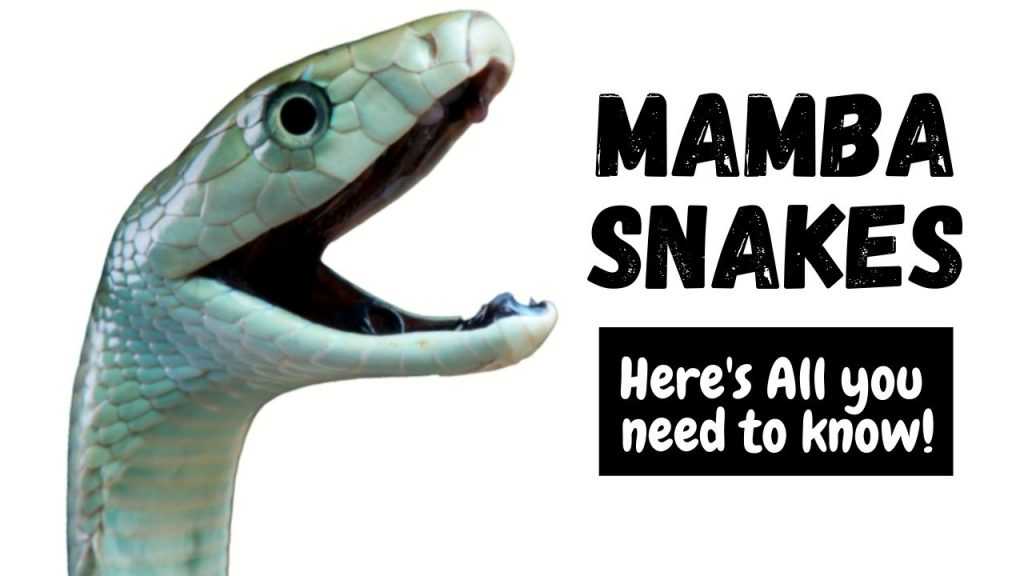The Mamba snakes are the dangerous and venomous species belonging to the family Elapidae, to which cobras also belong and to the genus Dendroaspis. Mamba snakes are famous for their speed and deadliness. The four species of Mamba snakes are known and recognized.

Habitat of the Mamba Snakes
The Mamba snakes are broadly found around the continent of Africa. It won’t be wrong saying that Africa is surrounded by Mamba snakes from all sides. Eastern Africa, Central Africa, southern Africa, western Africa, Sudan, Kenya, Somalia, Zimbabwe, Uganda, and similar regions are outnumbered with the species of Mamba snakes.
Physical Characteristics of the Mamba Snakes
The large, sizzling, and threatening Mamba snakes are distinctive from other snake families in various features and characteristics.
Size
The Mamba snakes are shorter than King cobra but are termed as the second largest venomous snake. The size of the smallest species of Mamba snakes ranges from 4 feet to 6 feet, and that of the largest species ranges from 10 to 14 feet.
These snakes are delicate snakes with a thin and lightweight body. The maximum recorded weight of the Mamba species is 4 pounds.
Skin and Colors
The Mamba snakes usually have a dark-colored interstitial skin with the scaling of mostly green and yellow colors. The black Mambas do not have this colored scaling. They have a brownish-grey color.
Head and Neck
The Mamba snakes possess an elongated and narrow head. The heads have coffin-shaped, flat shapes, and their necks are also flat.
Mouth
The Black Mamba has a black mouth interior while the other three green species have a white or bluish-white interior mouth.
Venom
All of the Mamba species are highly venomous. Their venom contains neurotoxins, cardiotoxins, fasciculins, calcicludine, and calciseptine. The venom of the Mamba species is so toxic and fatal that only two drops of this venom can kill a human being.
Species of The Mamba Snakes
Mamba snakes have the following four famous species.
Black Mamba
Black Mamba is the most famous species of this family and is the deadliest snake found in Africa. The scientific name for Black Mamba is Dendroaspis polylepis
The Black Mamba snake is not black. It has a dark brownish color with grey and green tones. It is called as Black Mamba due to the interior black coloring of its mouth. This black mouth is enough to horrify the victim, prey or predator when the snakes open their mouth.
Mamba snake is the second-longest snake in the family of venomous snakes, first being the King Cobra. The average length of a Black Mamba snake is 10 to 14 feet.
This black Mamba snake can run faster than a running human being, with a slithering speed of 12 mph. they use this speed, not for hunting, but to escape from a dangerous situation. They are terrestrial snakes that are rarely found on the trees, just for basking.
Black Mamba snakes are in the same family of Cobra as it can also spread their neck flaps when they get threatened. They hunt in the day time and go to sleep at night at the same place every time. They like to hunt small birds and mammals.
The Black Mamba snakes are found in eastern Africa, southern Africa, northeast Congo, southwestern Sudan, Angola, Djibouti, Tanzania, Kenya, Eastern Uganda, Mozambique, Swaziland, Lesotho, Rwanda, Namibia, Malawi, Zambia, Ethiopia, Eritrea, Somalia, Botswana, Kwazulu- Natal, and Zimbabwe.
The Black Mamba snakes can live up to 11 years.
Eastern Green Mamba
The Eastern Green Mamba is one of the most venomous snakes. It is mainly found in southern East Africa. The scientific name for Eastern Green Mamba is Dendroaspis angusticeps.
Eastern Green Mamba is one of the three species of Mamba snakes with green color. They are large snakes but shorter than the Black Mamba. The average size of the Eastern Green Mamba is 6 to 7 feet.
The body of the Eastern Green Mamba is green with yellowish scales. The juveniles have a blue-green appearance and start turning green when they reach the size of about 2 feet.
The eastern green mambas are active during the day. They are rarely found on the ground. They are the arboreal snakes living on the trees.
The Easter Green Mambas are mostly found in eastern African regions like Sudan, Congo, Tanzania, Zimbabwe, Swaziland, Chad, Niger, Malawi, Kenya, and Mozambique.
The Eastern Green Mamba snakes live up to 14 years.
Jameson’s Mamba
Jameson’s Mamba is a high speed and highly venomous snake of Elapidae, native to Africa. The scientific name for Jameson’s Mamba is Dendroaspis jamesoni.
Jameson’s Mamba is a large and delicate snake species with some scales on its body and a long tapering tail. The average length of a Jameson’s Mamba snake is 5 to 7 feet. This species has a dull to pale green color with scales having black markings.
They have a long and narrow head with a flat neck and small eyes. The ventral side and neck have a yellowish or creamy light color.
The Jameson’s Mamba snakes are very active, agile, and fast-moving snakes. It shows most arboreal behavior in the species of Mamba and spent most of their lives on the trees.
The Jameson’s Mamba snakes are found in Central and Western Africa. The regions like Sudan, Ghana, Angola, Rwanda, Benin, Kenya, Cameroon, Congo, Zambia, and Gabon possess the most population of Jameson’s Mamba snakes.
These snake species have an expected life span of 9 years.
Western Green Mamba
Western Green Mamba is a large, arboreal, and highly venomous species of the family Elapidae. This green species of Mamba has a scientific name as Dendroaspis viridis. It is also known as West African Green Mamba and Hallowell’s Green Mamba.
This highly alert, active, and agile species is found in the thick rainforests of the West African regions. The dorsal body of a western green mamba is yellowish-green with the scales having yellow edges. The vertical side and tail of this species are mostly yellow. The black interstitial skin of the western green snakes is quite visible in some species with yellow and green scaling.
The average length of the western green mamba snakes is 4 to 7 feet. Some species with 8 feet length have also been recorded. They like to eat small mammals, birds, and rodents like rats, mice, and squirrels.
This species of Mamba snakes are widely found in the coastal tropical rainforests of Gambia, Sierra Leone, Togo, Benin, Senegal, Guinea, Liberia, Nigeria, Ghana, and Guinea- Bissau.
This snake species can live a 13 to 18 years long life in the wild.
Behavior and Habits of Mamba Snakes
The Mamba snakes are not very explosive or aggressive species. They are shy species and try most of the time to escape and avoid interaction with humans.
The Black Mamba is a highly terrestrial species while the other three green species are arboreal. Mamba snakes are diurnal species that hunt at day time and sleep at night.
When the Mamba snakes get threatened, they lift the front part of their body in the air up to 4 feet high, spread their neck flaps like Cobra, and open their horrible mouths.
Feeding and Attacking of the Mamba Snakes
The Mamba snakes are venomous. They strike their prey with their fangs and inject the deadly venom into its body. The snakes wait for the prey to get paralyzed or die and swallow the prey.
The Mamba snakes like to hunt small mammals, birds, squirrels, rats, mice, rabbits, and bats. The Mamba snakes have a fast metabolism and can digest their food as fast as 10 hours.
Reproduction of the Mamba Snakes
The Mamba snakes are oviparous meaning that they lay eggs. The mating season takes place in spring or early summer. The male snakes fight to mate with one female. After mating, the female lays 15 to 30 eggs in a debris area and leave them. The eggs hatch on their own.
Final words
The Mamba snakes are deadly and venomous. Their existence else than wildlife can be a threat to humans.
[box type=”shadow” align=”” class=”” width=””]Other Snakes from the Elapidae family we’ve REVIEWED:
[tie_list type=”lightbulb”] [/tie_list] [/box]






